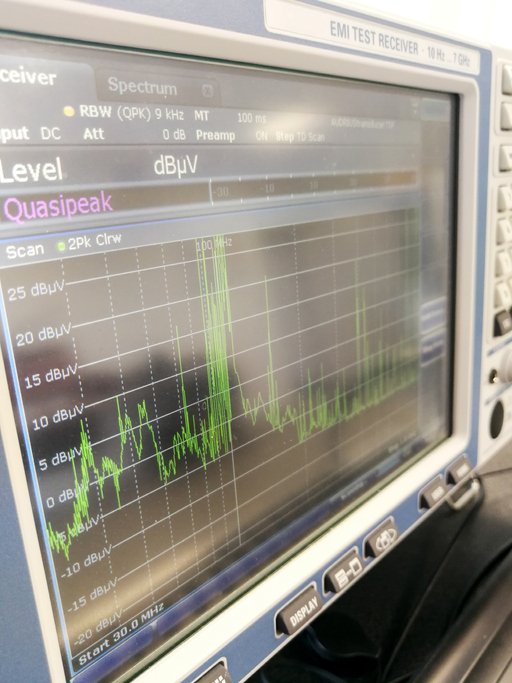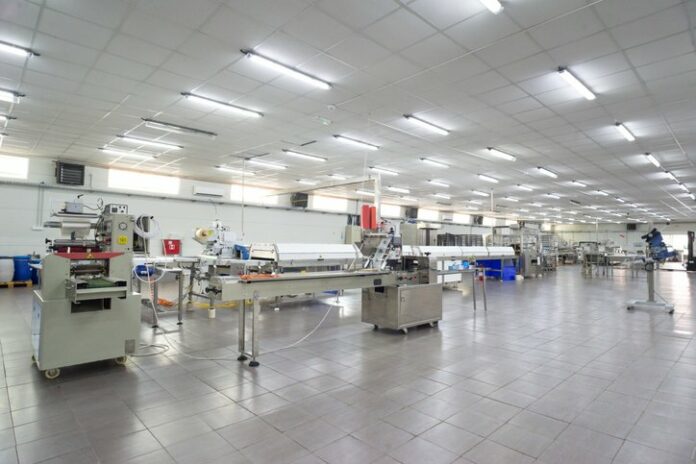LED lighting being used in a commercial warehouse.
In 2022, the U.S. Energy Information Administration (EIA) found that the commercial sector used around 146 billion kilowatt hours (kWh) just on lighting alone[1]. That makes up roughly 11% of all electricity used that year. In an effort to lower energy costs, many businesses have begun making the switch to LED fixtures and retrofits.
It’s no secret that LED technology is far more efficient than fluorescents and other older lighting technologies. However, some LED fixtures and retrofits are made to meet much higher standards and also provide additional savings and benefits. To take advantage of these benefits, look for LED products with the DesignLights Consortium® (DLC) logo.
We’ve covered DLC 4.0 in the past, but we’ve never taken an in-depth look at what DLC actually is and does. So today, we’ll cover DLC, their programs, and how their products can benefit you.
Who is DesignLights Consortium and What Do They Do?

DLC is a non-profit organization that first began in 1998 as part of a commercial lighting initiative put together by the Northeast Energy Efficiency Partnerships. Consisting of a group made up of various energy efficiency program managers, their goal was to create a set of guides for lighting commercial spaces. These guides included codes and standards, best practices, and efficient lighting equipment available at the time. As lighting technology has advanced, these guides have evolved into a set of standards commonly used throughout the industry.
DLC Fact: DLC is a voluntary certification initiative. Complying with DLC standards is not mandatory, however many manufacturers are adopting their standards due to consumer demand.
Today, DLC is a leader in promoting energy efficiency for the commercial lighting sector. They collaborate with manufacturers, lighting designers, entities at all levels of state and federal government, and utility and energy efficiency programs to promote high quality energy-efficient products and lighting control systems. DLC has the largest list of verified high performance LED lighting products, called the Qualified Products List (QPL), and a wide range of tools to help businesses find the lighting they need.
Most of DLC’s policies and standards are created with the help of the Industry Advisory Committee (IAC). A 15 to 17-person committee, the IAC is made of various members who work for lighting manufacturers, lighting designers, and distributors. Members are nominated and are either elected by their peers or directly approved by DLC. Once elected or approved, each member has a term limit of 2 years. The current IAC includes members from RAB Lighting, Acuity Brands, OSRAM, EiKO, and more[2].
What are the Current DLC Lighting Requirements?
DLC currently has four different programs: Solid-State Lighting, Horticultural Lighting, Networked Lighting Controls, and LUNA. Each program has its own set of standards and requiremtns that are geared towards ensuring products operate efficiently while using less energy. These standards are updated regularly to incorporate the growing needs of customers and advancements in technology.
Solid-State Lighting
Products meeting SSL DLC lighting requirements will have one of these logos.
Solid-State Lighting (SSL) covers LED fixtures and retrofit kits. Two policies were implemented in 2020. DLC 5.0 focuses on increasing minimum efficacy 10 to 23% depending on the category. New dimming requirements were also part of this policy, but were revised due to the ongoing disruptions caused by COVID-19.[3] This policy was delisted on June 30, 2022.
The second policy, DLC 5.1, is currently active and includes new color, glare, and controllability standards. With these new policies for commercial lighting, DLC estimates that there will be an annual savings of 10 to 20-terawatt hours (TWh) through 2035.[4] The policy also allows for two levels: Standard and Premium.
DLC Standard requirements include minimum light output and efficacy requirements that vary depending on the fixture or retrofit kit type. DLC Premium has it’s own set of efficacy minimum performance standards that exceed DLC Standard requirements for efficacy. This allows fixture meeting Premium qualifications to achieve higher energy savings.
DLC Fact: While lamps (bulbs) are eligible for 5.1 Standard DLC certification, they are not eligible for 5.1 Premium.
Networked Lighting Controls
The Networked Lighting Controls (NCL) program details guidelines for interior and exterior lighting control systems designed to control an entire building. These systems are made up of a combination of network interfaces, controllers, and sensors that help further increase efficiency of the lighting. The current policy, Version 5 (NCL5), builds on energy plans, cybersecurity, and interoperability to help increase the reliability of these systems.[5] NCL5 also oversaw the launch of the NCL QPL database as well as a variety of training programs.
Horticultural Lighting
DLC HORT log.
The Horticultural Lighting program (HORT) is aimed at ensuring LED grow lighting fixtures are well designed and efficient. Controlled Environment Agriculture (CEA) has seen rapid growth over the last several years, especially in the commercial market. Many utilities have noted that this has become one of their fasted growing electrical loads.[6] The HORT program is designed to support the adoption of energy efficiency practices in CEA by implementing LED lighting and controls.
The current version, 3.0, took effect March 31, 2023. It increases efficacy by 21% over HORT V2.1 and has new requirements for reporting the intended use of products, dimensions, and images. Other updates in include the introduction of product-level controllability requirements and a surveillance testing policy[8].
LUNA
LUNA logo.
LUNA is DLC’s newest program, centering on mitigating the impact of outdoor lighting at night. Focusing on reducing light pollution, this program builds upon the principles and requirements of DarkSky International. It is governed under five principles[9]:
-
Useful – All lights should be needed and serve a clear purpose, and you must consider any impacts on the environment and wildlife.
-
Targeted – Light should only be directed where it is needed to avoid light spillage.
-
Lot Light Levels – Lights should be no brighter than what is necessary to avoid light spillage.
-
Controlled – Light should only be used when needed. Timers and/or motion sensors should be paired with the fixtures.
-
Color – Lights should use warmer color temperatures where possible.
All LUNA qualified products must meet SSL 5.1 technical requirements as a baseline and fall into the Primary Use Designation (PUDs) listed in the LUNA V1.0 documentation.
How do Products Get Qualified?
EMI readout completed at an accredited laboratory.
As mentioned earlier, DLC programs are entirely voluntary. Manufacturers submit an application along with product documentation such as spec sheets, warranties, and brochures. Some programs also require that products be sent to an accredited laboratory for testing. The results must be submitted as part of the application documentation. DLC will then review the documents and may ask questions as needed. After the review process, approved products are listed in the program’s QPL database and are considered ‘DLC Qualified’. Manufacturers can then place the appropriate labels on product packaging and documentation. Products tested for SSL that exceed the current standards are labeled DLC Premium.
DLC Fact: You can browse the QPLs and verify qualified products by visiting the DLC website.
In 2019[7], DLC had 99,000 qualified products submitted to the SSL program, with 37% of those listed as DLC Premium. They also reported that 54,000 products already listed in the SSL’s QPL were updated. The NLC had 47 new systems qualified, while the Horticultural Lighting program had 38 fixtures qualified. In 2022[10], 99.5% of the fixtures and lamps meeting SSL qualifications were dimmable. Plus, 75% of those products feature integrated controls.
What Are the Benefits of Using DLC Qualified Products?
DLC listed products can help reduce energy, maintenance, and replacement costs.
By choosing qualified LED fixtures and retrofits, you know that you are getting high-end products that meet the strict standards of DLC and provide exceptional energy savings to commercial customers. The longer lifespan of these products also helps reduce maintenance and replacement costs. Pairing DLC fixtures and retrofits with qualified control systems can further increase these savings. According to one case study completed by Philips[11], the initial install of DLC qualified LED fixtures in the Rhode Island Public Utilities Commission reduced their energy costs by an estimated 64%. Once these fixtures were paired with an NCL qualified control system, the savings increased to 67%.
DLC Qualified products may also be eligible for state or local rebates depending on where you live, providing an additional incentive to make the switch to more efficient lighting. To find rebates, you will need to check with your local utility companies or on state websites. National databases, such as the Database of State Incentives for Renewables & Efficiency (DSIRE), let you search for potential rebates by zip code.
1000Bulbs.com carries a wide range of commercial fixtures and retrofits that are DLC Qualified and DLC Premium listed. For assistance finding the right products for your application, please call 1-800-624-4488 to speak with one of our US-based product experts.
Sources:
1 – U.S. Energy Information Administration – https://www.eia.gov/tools/faqs/faq.php?id=99&t=3
2 – Industry Advisory Committee – https://www.designlights.org/about-us/industry-advisory-committee/
3 – Transition to SSL V5 Requirements – https://www.designlights.org/solid-state-lighting/qualification-requirements/v5-transition/
4, 5, 7 – DLC 2019 Annual Report – https://www.designlights.org/default/assets/File/DLC-annual-report-2019.pdf
6 – Horticultural Technical Requirements V2.0 – https://www.designlights.org/workplan/horticultural-technical-requirements-v2-0/
8 – DLC Horticultural Technical Requirements V3.0 – https://www.designlights.org/our-work/horticultural-lighting/technical-requirements/hort-v3-0
9 – LUNA Technical Requirements V1.0 – https://www.designlights.org/our-work/luna/technical-requirements/luna-v1-0/
10 – DLC 2022 Annual Report – https://www.designlights.org/wp-content/uploads/2023/11/DLC_AnnualReport_2022_FINAL.pdf
11 – DLC Advanced Lighting Technology Demonstration: Philips SpaceWise – https://www.designlights.org/wp-content/uploads/2021/02/DLC_Advanced-Lighting-Fact-Sheet_Philips-SpaceWise.pdf
blog.1000bulbs.com










